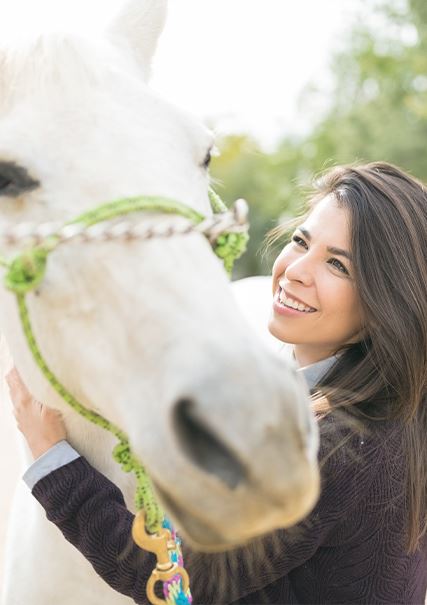Equine Therapy
A Complement to Addiction Recovery
Equine therapy is often used in combination with other traditional treatments and therapies in an effort to improve outcomes for people recovering from drug or alcohol addiction. Aside from the opportunity to experience something new, interacting with horses can also be fun.
Horses can be inquisitive, playful, obstinate, nervous, accepting, affectionate, or even skittish. There’s never an easy way to tell how a horse will respond to meeting different people. However, the horse’s response to meeting a person in recovery during a therapy session can tell a mental health therapist much about that person’s emotional state. From that starting point, therapy can begin as they work through the recovery process.
A Reflection in Behavior
A curious aspect of equine therapy is that people often learn much about how they interact with others by interacting with horses. Typical things that can cause problems in their lives will often happen during the therapy session.
For example, if a person has a tendency to be over-accommodating, they will likely over-accommodate with the horse. If a person has a tendency to control other people, it’s likely they will try to control the horse’s behavior too.
Equine therapy is a great opportunity for recovering people to actually see their behaviors in action. The horse’s responses are often immediate, which makes it easy to observe how those behaviors are really affecting others and potentially causing problems.
What Is Equine Therapy?
Equine therapy is a specific type of therapy that focuses on experience and interaction between people and horses. The objective of equine therapy is to encourage recovering people to provide care for and spend time with horses in a therapeutic setting.
Therapeutic Activities
The majority of equine therapy sessions involve certain activities that may include grooming, feeding, or leading a horse around. Sessions are usually supervised by a licensed mental health therapist, often in conjunction with an equine professional.
While riding can sometimes be a part of equine therapy, the majority of important work occurs during interactions between the recovering person and the horse. People begin to learn a bit more about their conscious or unconscious patterns of interacting with other people.
Equine therapy typically involves:
- Interacting with the Horses – When they hear they’re going to an equine therapy session, most people immediately think they’re being led into a horse-riding lesson to ride around on ponies for a while. Yet in reality, equine therapy is more strongly focused on interacting with horses than with riding.
- Grooming – Recovering people are encouraged to participate in grooming the horses. Using repetitive physical actions, such as brushing or currying, helps to promote a sense of relaxation and acceptance for both the person and the horse.
- Fitting a Halter – Simple tasks, such as fitting a halter to a horse, may seem simple enough. However, horses have an innate ability to react to the emotions of people around them. If the person trying to fit a halter is feeling aggressive or irritable, the horse is likely to become stubborn and difficult. Likewise, if the person is feeling anxious, the horse could become skittish.
Throughout an equine therapy session, a horse’s responses can teach a recovering person much about self-awareness. Watching the horse’s responses allows people to view their own actions and approaches, which gives them the opportunity to become more aware of their inner thoughts and feelings.
What Happens in an Equine Therapy Session?
An equine-assisted therapy session basically takes an in-office therapy session outside into a paddock, field, barn, or arena for a period of time. Each therapist may have slightly different activities they work through, but the structure of therapy sessions is usually similar.
- Herd Dynamic Observation – People who are new to equine therapy may not be willing to interact directly with the horses right away. Instead, they might be encouraged to remain on the sidelines and watch the herd dynamic of several horses before them. They might not realize it at the time, but the herd will often reflect or mirror the feelings and emotions the recovering person is experiencing at that time.
- Structured Activities – As part of the therapy sessions, the recovering person will be asked to participate in some of the structured activities. These might include simple things, such as grooming, or evolve to more involved interactions, such as leading a horse around a course.
The actual activities used may vary between therapists and can sometimes be determined by which horses are available and the recovering people participating in each session. When it comes right down to it, the objective is to encourage participants to spend time with a gentle, non-judgmental animal in a therapeutic setting.
Equine Therapy for Addiction Recovery
Working with horses under the careful supervision of a trained equine therapist offers people several unique opportunities. Perhaps the most obvious benefit is the opportunity to be outdoors in nature and learning to care for another living being.
For some people, the responsibility of taking care of a large animal can be humbling. For others, it can be a new way to develop empathy for how the horse may feel in response to their actions or attention.
Mirror Behaviors
Horses are experts at mirroring the behaviors, emotions, and attitudes of humans, particularly when working so closely with them. A recovering person has the opportunity to see their own negative attitudes or behaviors mirrored back at them through a large animal under their care.
Throughout an equine psychotherapy session, it’s then possible to identify and recognize some of their own tendencies towards self-defeating or negative behaviors. The self-awareness of conscious or unconscious patterns of interacting with others is helpful for teaching an understanding of how behaviors and attitudes impact others.
Develop Self-Confidence
Working closely with horses also helps people build and develop self-confidence. Throughout an equine therapy session, the recovering person is learning responsibility and accountability as the attention, they provide the horses is in the form of valued tasks in the overall care of the animals.
After the equine component of the session is complete, therapists then work with recovering people to discuss any realizations they may have had during the experience. For people who don’t take too well to talking in one-on-one therapy or counseling sessions, working with horses offers a non-verbal way to begin processing different experiences in a positive way.
Benefits of Equine Therapy during Recovery
Research shows that equine-assisted therapy can significantly reduce symptoms of anxiety and depression. Participants in equine therapy studies also displayed increased mindfulness strategies.
Face Strong Emotions
Horses are big animals, so people either love them or fear them. Love and fear are two big emotions. Those who fear horses might not just fear their large size. They may also have a fear that the animal somehow won’t like them, which can reflect in the way they interact and approach equine therapy sessions.
Facing those strong emotions can be challenging for many recovering people, but once they recognize that horses are also gentle, non-judgmental creatures, it becomes easier to process those emotions with more confidence.
Processing vs. Escaping
Another important benefit of an equine therapy session is that recovering people begin to learn how to experience emotions and feelings again without trying to escape. Many people caught in a cycle of addiction may have turned to drugs or alcohol in an effort to self-medicate as an escape from painful feelings or to numb emotions.
During equine therapy, recovering people begin to experience different emotions related to working so closely with such beautiful, accepting creatures. Therapy then helps them learn ways to cope with those feelings and emotions without feeling the need to escape.
Learning Trust
Perhaps one of the most underestimated benefits of participating in equine therapy sessions is learning trust. It’s common for many people in recovery from drug or alcohol addiction to develop a sense of mistrust for people around them.
Spending time with horses can help develop trust. Horses are big animals, but they’re also gentle, inquisitive creatures. Recovering people begin to learn that it really is possible to build trust in a living being that is much bigger than they are.
Is Equine Therapy Covered by Medical Insurance?
In most cases, equine-assisted therapy should be reimbursed by most third-party medical insurance companies. However, therapeutic riding sessions are not covered by medical insurance, simply because riding is considered a recreational activity.
Integrating Equine Therapy into Life after Treatment
Just because rehab has ended doesn’t mean treatment should also stop. Recovery is an ongoing journey, so it’s important that people leaving rehab are equipped with a range of coping skills, recovery tools, and resources designed to help them maintain abstinence over the long term.
Aftercare
Addiction treatment specialists usually work closely with people who are ready to leave rehab to create a strong aftercare program. Aftercare programs are designed to provide ongoing treatment, therapy, or support throughout the recovery process.
Ongoing Participation
For those people who enjoyed and benefited by attending equine therapy during rehab, finding a way to continue participating in sessions even after leaving treatment is beneficial.






